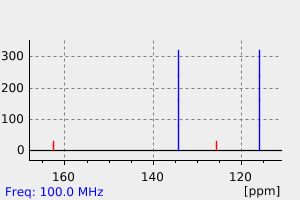4,4'-difluorodiphenyl diselenide | 52673-29-7
中文名称
——
中文别名
——
英文名称
4,4'-difluorodiphenyl diselenide
英文别名
1,2-bis(4-fluorophenyl)diselane;bis(4-fluorophenyl) diselenide;bis-p-fluorophenyl diselenide;di(p-fluorophenyl) diselenide;Diselenide, bis(4-fluorophenyl);1-fluoro-4-[(4-fluorophenyl)diselanyl]benzene
CAS
52673-29-7
化学式
C12H8F2Se2
mdl
——
分子量
348.112
InChiKey
SDLBMJQKOPWWGV-UHFFFAOYSA-N
BEILSTEIN
——
EINECS
——
-
物化性质
-
计算性质
-
ADMET
-
安全信息
-
SDS
-
制备方法与用途
-
上下游信息
-
文献信息
-
表征谱图
-
同类化合物
-
相关功能分类
-
相关结构分类
计算性质
-
辛醇/水分配系数(LogP):1.24
-
重原子数:16
-
可旋转键数:3
-
环数:2.0
-
sp3杂化的碳原子比例:0.0
-
拓扑面积:0
-
氢给体数:0
-
氢受体数:2
SDS
上下游信息
反应信息
-
作为反应物:描述:参考文献:名称:铜配合物和碳纳米管-铜铁氧体催化苯醌的苯环A环硒化:合成锥虫杀伤剂的有效方法†摘要:我们报告了萘醌和蒽醌的A环硒化的新方法,并讨论了合成化合物的相关锥虫活性。我们已经证明了制备目标硒衍生物的三种有效策略,即(a)铜(I)噻吩-2-羧酸铜和原位生成的Santi试剂用于制备硒取代的苯并醌醌,(b)铜配合物和(c)碳纳米管负载的铜铁氧体在AgSeR盐存在下作为催化剂,也用于合成含硒的醌型衍生物。这些新方法为制备硒基醌提供了有效而实用的策略。此外,我们发现了九种具有强效杀锥虫活性的化合物。衍生物2a-2e表现出强效的锥虫杀虫活性,IC 50值在13.3至37.0μM的范围内。DOI:10.1039/c9nj02026h
-
作为产物:描述:4-氟苯硼酸 在 selenium(IV) oxide 、 丙二腈 、 potassium hydroxide 作用下, 以 二甲基亚砜 为溶剂, 生成 4,4'-difluorodiphenyl diselenide参考文献:名称:铜辅助芳烃的(拟)卤硫代反应摘要:在本报告中,我们描述了芳炔、(拟)卤化物和亲电子硫族元素之间的多组分偶联反应。添加铜盐可以抑制副反应,从而实现顺利的转化。采用了各种不同的芳基前体以及硒代磺酸盐和硫代磺酸盐,产生了广谱的邻(拟)卤化硫属化物。该基序采用了不同的交叉偶联方法,证明了这些化合物作为更复杂结构的构建模块的适用性。DOI:10.1021/acs.orglett.4c00498
-
作为试剂:描述:二苯甲酮 在 4,4'-difluorodiphenyl diselenide 、 双氧水 作用下, 以 水 、 乙腈 为溶剂, 反应 24.0h, 生成 3-methyl-2,2-di-phenylcyclobutan-1-one 、 4-methyl-2,2-diphenylcyclobutan-1-one参考文献:名称:亚砜催化过氧化氢对亚甲基环丙烷的氧化环扩容摘要:催化剂的筛选和反应条件的优化使得可以控制有机硒催化的高活性亚甲基环丙烷的氧化环扩展,从而选择性地产生取代的环丁酮。该方案采用H 2 O 2作为清洁氧化剂,不产生废物,因此,在温和条件下提供了绿色获得有用但不易获得的取代的环丁酮的途径。DOI:10.1002/cctc.201501309
文献信息
-
Visible-light-induced oxidative coupling of vinylarenes with diselenides leading to α-aryl and α-alkyl selenomethyl ketones作者:Gong-Qing Liu、Wei Yi、Peng-Fei Wang、Ji Liu、Meng Ma、Da-Yun Hao、Liang Ming、Yong LingDOI:10.1039/d1gc00049g日期:——A visible-light-induced oxidative coupling of diselenides with readily available vinylarenes is demonstrated. This benign protocol allows one to access a wide range of α-aryl and α-alkyl selenomethyl ketones in good yields with excellent functional group compatibility. The distinct advantages of this protocol over all previous methods include the use of a green solvent and air as an oxidant and the
-
α-Arylchalcogenation of acetone with diaryl dichalcogenide via metal-free oxidative C(sp3)–H bond functionalization作者:Guobing Yan、Arun Jyoti Borah、Lianggui Wang、Zhangjin Pan、Shuangshuang Chen、Xuqian Shen、Xiangmei WuDOI:10.1016/j.tetlet.2015.05.059日期:2015.7Direct α-arylchalcogenation of acetone with diaryl dichalcogenides has been achieved by using a mixture of TBHP and DTBP oxidants at 120 °C without transition-metal catalyst via oxidative C(sp3)–H bond functionalization. The method exhibits good functional group tolerance and products were isolated in moderate to high yields.
-
Ruthenium Catalyzed C–H Selenylations of Aryl Acetic Amides and Esters via Weak Coordination作者:Zhengyun Weng、Xinyue Fang、Meicui He、Linghui Gu、Jiafu Lin、Zheyu Li、Wenbo MaDOI:10.1021/acs.orglett.9b02196日期:2019.8.16An efficient ruthenium-catalyzed direct C–H selenylation of aryl acetic amides and esters has been achieved via distal weakly coordination. Notable features of this protocol including broad substrate scope, wide functional group tolerance, and good regioselectivity. In addition, diaryl disulfides were also successfully applied to this reaction under slightly modified conditions.
-
Organoselenium compounds from purines: Synthesis of 6-arylselanylpurines with antioxidant and anticholinesterase activities and memory improvement effect作者:Luis Fernando B. Duarte、Renata L. Oliveira、Karline C. Rodrigues、Guilherme T. Voss、Benhur Godoi、Ricardo F. Schumacher、Gelson Perin、Ethel A. Wilhelm、Cristiane Luchese、Diego AlvesDOI:10.1016/j.bmc.2017.11.019日期:2017.12We describe here a simple method for the synthesis of 6-arylselanylpurines with antioxidant and anticholinesterase activities, and memory improvement effect. This class of compounds was synthesized in good yields by a reaction of 6-chloropurine with diaryl diselenides using NaBH4 as reducing agent and PEG-400 as solvent. Furthermore, the synthesized compounds were evaluated for their in vitro antioxidant
-
Transition metal-free coupling reactions of benzylic trimethylammonium salts with di(hetero)aryl disulfides and diselenides作者:Fuhai Li、Dan Wang、Hongyi Chen、Ze He、Lihong Zhou、Qingle ZengDOI:10.1039/d0cc05633b日期:——A new protocol was developed to synthesize (enantioenriched) thioethers and selenoethers from (chiral) benzylic trimethylammonium salts and di(hetero)aryl disulfides or diselenides. These syntheses were promoted by the presence of weak base and did not require the use of any transition metal, and resulted in the target products with good to excellent yields (72–94%). Using quaternary ammonium salts
表征谱图
-
氢谱1HNMR
-
质谱MS
-
碳谱13CNMR
-
红外IR
-
拉曼Raman
-
峰位数据
-
峰位匹配
-
表征信息
同类化合物
(βS)-β-氨基-4-(4-羟基苯氧基)-3,5-二碘苯甲丙醇
(S,S)-邻甲苯基-DIPAMP
(S)-(-)-7'-〔4(S)-(苄基)恶唑-2-基]-7-二(3,5-二-叔丁基苯基)膦基-2,2',3,3'-四氢-1,1-螺二氢茚
(S)-盐酸沙丁胺醇
(S)-3-(叔丁基)-4-(2,6-二甲氧基苯基)-2,3-二氢苯并[d][1,3]氧磷杂环戊二烯
(S)-2,2'-双[双(3,5-三氟甲基苯基)膦基]-4,4',6,6'-四甲氧基联苯
(S)-1-[3,5-双(三氟甲基)苯基]-3-[1-(二甲基氨基)-3-甲基丁烷-2-基]硫脲
(R)富马酸托特罗定
(R)-(-)-盐酸尼古地平
(R)-(-)-4,12-双(二苯基膦基)[2.2]对环芳烷(1,5环辛二烯)铑(I)四氟硼酸盐
(R)-(+)-7-双(3,5-二叔丁基苯基)膦基7''-[((6-甲基吡啶-2-基甲基)氨基]-2,2'',3,3''-四氢-1,1''-螺双茚满
(R)-(+)-7-双(3,5-二叔丁基苯基)膦基7''-[(4-叔丁基吡啶-2-基甲基)氨基]-2,2'',3,3''-四氢-1,1''-螺双茚满
(R)-(+)-7-双(3,5-二叔丁基苯基)膦基7''-[(3-甲基吡啶-2-基甲基)氨基]-2,2'',3,3''-四氢-1,1''-螺双茚满
(R)-(+)-4,7-双(3,5-二-叔丁基苯基)膦基-7“-[(吡啶-2-基甲基)氨基]-2,2”,3,3'-四氢1,1'-螺二茚满
(R)-3-(叔丁基)-4-(2,6-二苯氧基苯基)-2,3-二氢苯并[d][1,3]氧杂磷杂环戊烯
(R)-2-[((二苯基膦基)甲基]吡咯烷
(R)-1-[3,5-双(三氟甲基)苯基]-3-[1-(二甲基氨基)-3-甲基丁烷-2-基]硫脲
(N-(4-甲氧基苯基)-N-甲基-3-(1-哌啶基)丙-2-烯酰胺)
(5-溴-2-羟基苯基)-4-氯苯甲酮
(5-溴-2-氯苯基)(4-羟基苯基)甲酮
(5-氧代-3-苯基-2,5-二氢-1,2,3,4-oxatriazol-3-鎓)
(4S,5R)-4-甲基-5-苯基-1,2,3-氧代噻唑烷-2,2-二氧化物-3-羧酸叔丁酯
(4S,4''S)-2,2''-亚环戊基双[4,5-二氢-4-(苯甲基)恶唑]
(4-溴苯基)-[2-氟-4-[6-[甲基(丙-2-烯基)氨基]己氧基]苯基]甲酮
(4-丁氧基苯甲基)三苯基溴化磷
(3aR,8aR)-(-)-4,4,8,8-四(3,5-二甲基苯基)四氢-2,2-二甲基-6-苯基-1,3-二氧戊环[4,5-e]二恶唑磷
(3aR,6aS)-5-氧代六氢环戊基[c]吡咯-2(1H)-羧酸酯
(2Z)-3-[[(4-氯苯基)氨基]-2-氰基丙烯酸乙酯
(2S,3S,5S)-5-(叔丁氧基甲酰氨基)-2-(N-5-噻唑基-甲氧羰基)氨基-1,6-二苯基-3-羟基己烷
(2S,2''S,3S,3''S)-3,3''-二叔丁基-4,4''-双(2,6-二甲氧基苯基)-2,2'',3,3''-四氢-2,2''-联苯并[d][1,3]氧杂磷杂戊环
(2S)-(-)-2-{[[[[3,5-双(氟代甲基)苯基]氨基]硫代甲基]氨基}-N-(二苯基甲基)-N,3,3-三甲基丁酰胺
(2S)-2-[[[[[((1S,2S)-2-氨基环己基]氨基]硫代甲基]氨基]-N-(二苯甲基)-N,3,3-三甲基丁酰胺
(2S)-2-[[[[[[((1R,2R)-2-氨基环己基]氨基]硫代甲基]氨基]-N-(二苯甲基)-N,3,3-三甲基丁酰胺
(2-硝基苯基)磷酸三酰胺
(2,6-二氯苯基)乙酰氯
(2,3-二甲氧基-5-甲基苯基)硼酸
(1S,2S,3S,5S)-5-叠氮基-3-(苯基甲氧基)-2-[(苯基甲氧基)甲基]环戊醇
(1S,2S,3R,5R)-2-(苄氧基)甲基-6-氧杂双环[3.1.0]己-3-醇
(1-(4-氟苯基)环丙基)甲胺盐酸盐
(1-(3-溴苯基)环丁基)甲胺盐酸盐
(1-(2-氯苯基)环丁基)甲胺盐酸盐
(1-(2-氟苯基)环丙基)甲胺盐酸盐
(1-(2,6-二氟苯基)环丙基)甲胺盐酸盐
(-)-去甲基西布曲明
龙蒿油
龙胆酸钠
龙胆酸叔丁酯
龙胆酸
龙胆紫-d6
龙胆紫







